If you are looking for an extra beauty for your aquarium, surely you are at the right place. Extra tall aquarium plants have power to give an amazing view to your fish tank. This article introduces many beautiful and decorative extra tall aquarium plants.
Amazon Sword
Jump To
- 1 Amazon Sword
- 2 Corkscrew Vallisneria
- 3 Jungle Vallisneria
- 4 Ludwigia repens
- 5 Bacopa Caroliniana
- 6 Asian Ambulia
- 7 Lace Plant
- 8 Water Wisteria
- 9 Rotala Indica
- 10 Green Cabomba
- 11 Java Fern
- 12 Anacharis
- 13 Water Sprite
- 14 Brazillian Pennywort
- 15 Green Foxtail
- 16 Giant Hygro
- 17 Aponogeton Crispus
- 18 Cryptocoryne Wendtii
- 19 Hornwort
- 20 Italian Vallisneria
- 21 Moneywort
- 22 How to maintain tall aquarium plants
- 23 How to anchor tall aquarium plants in the tank
| Parameters | Values |
| Scientific Name | Echinodorus grisebachii |
| Family | Alismataceae |
| Care Level | Easy |
| Color | Dark green |
| Maximum Size | 16 Inches |
| Temperature | 60.8-82.40 F |
| pH | 6.5-7.5 pH |
| General Hardness | 8-150 dH |
| Light level | Moderate |
| Cost | Tiny healthy Amazon sword plant is about $3-4 |
Amazon sword is a famous tall aquarium plants . This plant is one of the fast-growing tall plants and it reaches 16 inches. This is the best selection for beginners. Because this Amazon sword can take care and maintain very easily.
Furthermore, it has the ability to survive a wide range of water parameters. This plant is very hardy; therefore, fertilization is not compulsory. But supplement with the right dose helps to growth of this aquarium plant.
Amazon sword does not need more lighting to live. It wants moderate lighting conditions. As an example, you must provide 2W of light per gallon for at least 11 to 12 hours every day.
Propagation of the Amazon sword
Amazon sword creates a long maternal stem. Plantlets can appear and after few days these small plantlets develop a root system and a couple of leaves gradually.
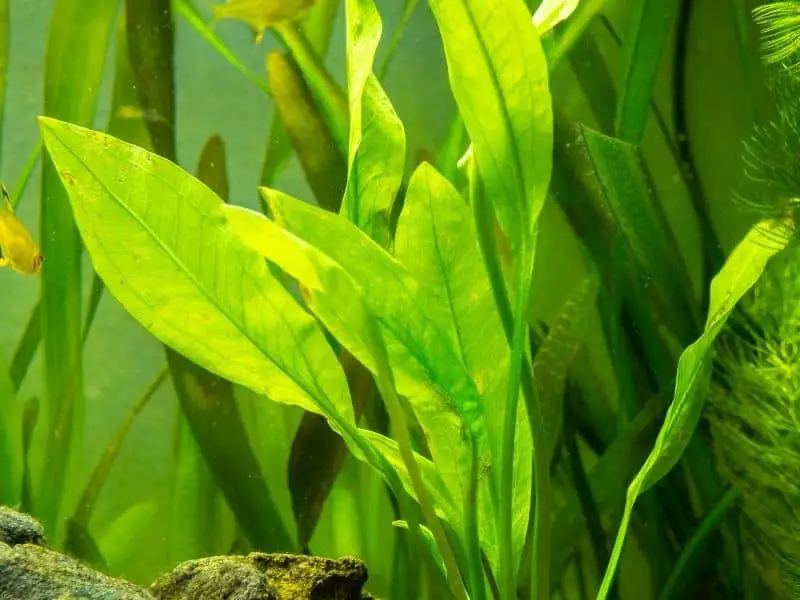
Corkscrew Vallisneria
| Parameters | Values |
| Scientific Name | Vallisneria torta |
| Family | Tapegrass |
| Care Level | Easy |
| Color | Grass green |
| Maximum Size | 20 Inches |
| Temperature | 68-82.5 °F |
| pH | 5-8 pH |
| General Hardness | Hard water |
| Light level | Moderate to High |
| Cost | $ 3-5 |
Corkscrew Vallisneria is another option for beginners. Because this plant is also easy to care and it is the best choice for small aquariums and the minimum tank size is 5 gallons.
These aquarium plants have the ability to grow in a gravel or sand substrate. Corkscrew Vallisneria needs decent lighting condition. Normally, these plants need 3 to 4W per gallon. You can reach a high growth rate of this plant by using fertilizers.
Propagation of Corkscrew Vallisneria
This plant propagates via stolons or runners. These runners normally spread anywhere in the tank.
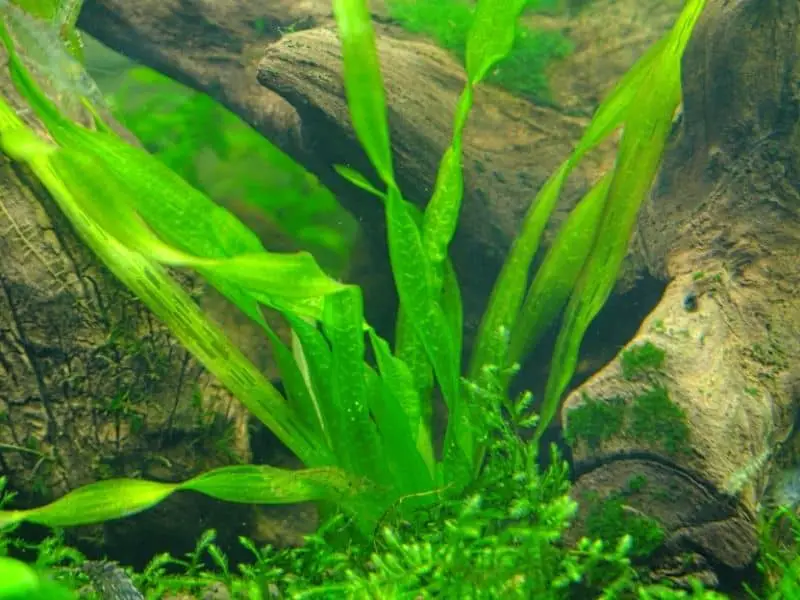
Jungle Vallisneria
| Parameters | Values |
| Scientific Name | Vallisneria Americana |
| Family | Hydrocharitaceae |
| Care Level | Intermediate |
| Color | Green |
| Maximum Size | 6 feets or 2 meters |
| Temperature | 65° – 85° F |
| pH | 6.8 – 8.0 |
| General Hardness | Moderately Hard to Very Hard |
| Light level | Medium |
| Cost | $7-8 |
Jungle Vallisneria is also called Jangle Val, Water Celery, Eelgrass, or Tape grass. This is a popular plant. This plant has the ability to reach the maximum growth of 6 feet.
Jungle Vallisneria can survive within moderate to high lightning conditions same as Corkscrew Vallisneria. The best substrate for this aquarium plant is sand or gravel. You must fertilize your Jungle Vallisneria plant regularly with iron-rich fertilizers.
Keep in mind to use liquid fertilizers and you can add them after the water change once a week. The minimum tank size required to this aquarium plant is 10 gallons.
Propagation of the Jungle Vallisneria
Jungle Vallisneria is reproduced through the runners. After sometimes, develop roots in these runners and gradually form a new plant.
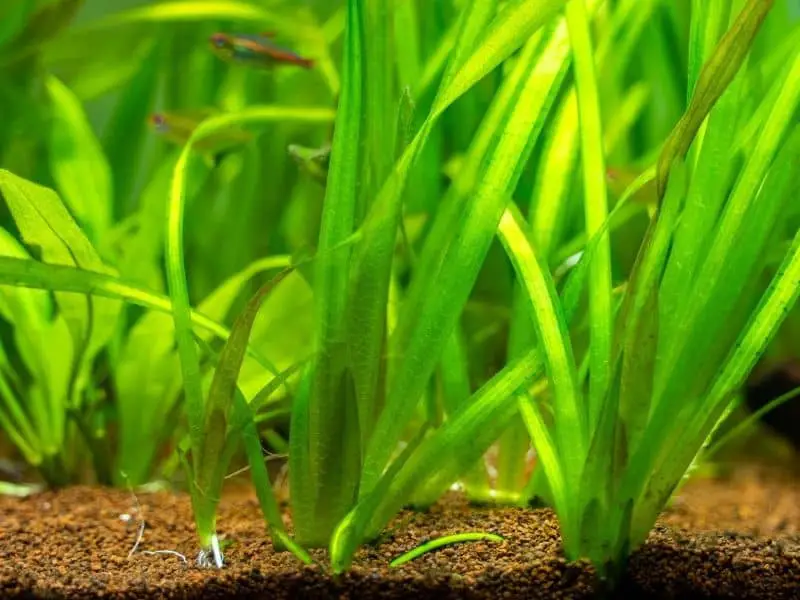
Ludwigia repens
| Parameters | Values |
| Scientific Name | Ludwigia repens |
| Family | Onagraceae |
| Care Level | Easy |
| Color | Leafe color range- dark green to brownish red or deep red |
| Maximum Size | 7-19 inches |
| Temperature | 60- 860F |
| pH | 5 – 8 pH |
| General Hardness | Very soft to hard level |
| Light level | Low to very high |
| Cost | $4-7 |
Ludwigia repens is also named Ludwigia repens Rubin, Red repens, Ludwigia sp. Weinrot, Red-Leaf Ludwigia, Creeping Primrose-Willow. This is the famous coloring aquatic plant.
Ludwigia repens can be survived in any lighting condition. But you should keep your plant at least 2 to 4 W per gallon light. If you provide more nutrients to your aquatic plant, it should be caused to reach the proper growth rate. However, you can use any substrate for this plant.
Propagation of Ludwigia repens
You can grow a new plant by cutting off the top shoots and then replant it in the substrate of your tank.
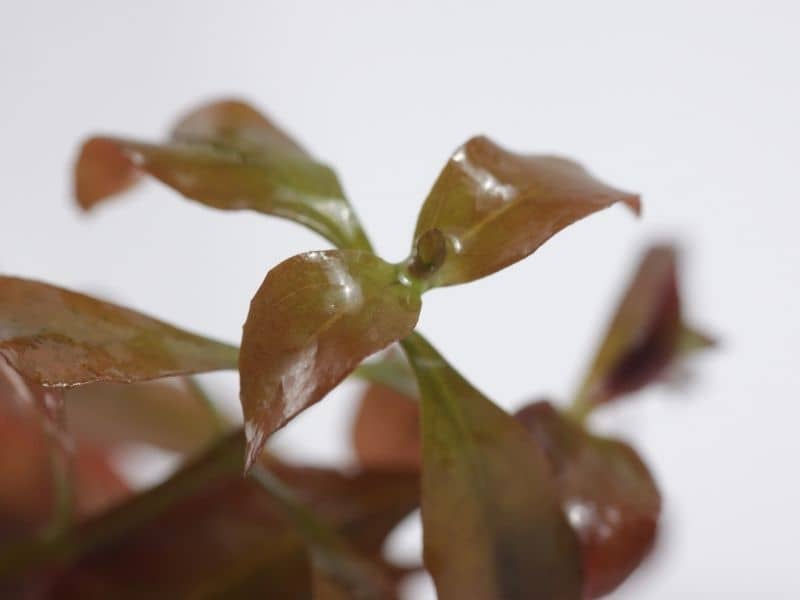
Bacopa Caroliniana
| Parameters | Values |
| Scientific Name | Bacopa Caroliniana |
| Family | Scrophulariaceae |
| Care Level | Easy |
| Color | Color range – green to yellow to pinkish color. |
| Maximum Size | 11+ inches |
| Temperature | 69.8 – 80.6°F |
| pH | 6.8 – 7.2 pH |
| General Hardness | 71.43 – 142.86 PPM |
| Light level | Low |
| Cost | $ 5-8 |
Bacopa Caroliniana has beautiful and attractive coloration and this aquatic plant grows rapidly. You should provide at least 2W of light condition per gallon for better performance of the plant. Any substrate is better for Bacopa Caroliniana.
Propagation of Bacopa Caroliniana
The lateral shoots help to generate a new plant. Cut off the lateral shoots and replant. You can cut about 3-6 inches.

Asian Ambulia
| Parameters | Values |
| Scientific Name | Limnophila sessiliflora |
| Family | Plantaginaceae |
| Care Level | Moderate |
| Color | Bright green |
| Maximum Size | 15 Inches |
| Temperature | 59-820 F |
| pH | 5-8 pH |
| General Hardness | 2-210 dKH |
| Light level | Low |
| Cost | $5 |
Asia Ambuli is known as Dwarf ambulli, Ambulis, Asian marshweed. This beautiful aquatic plant can survive in low lighting conditions. But a minimum rate of 0.5W per gallon should be required. This live aquarium plant can be grown within any substrate. The minimum tank size is 10-gallon.
Propagation of Asia Ambuli
The easiest propagation method is, cut off the top shoots and replant them in the substrate of your tank.
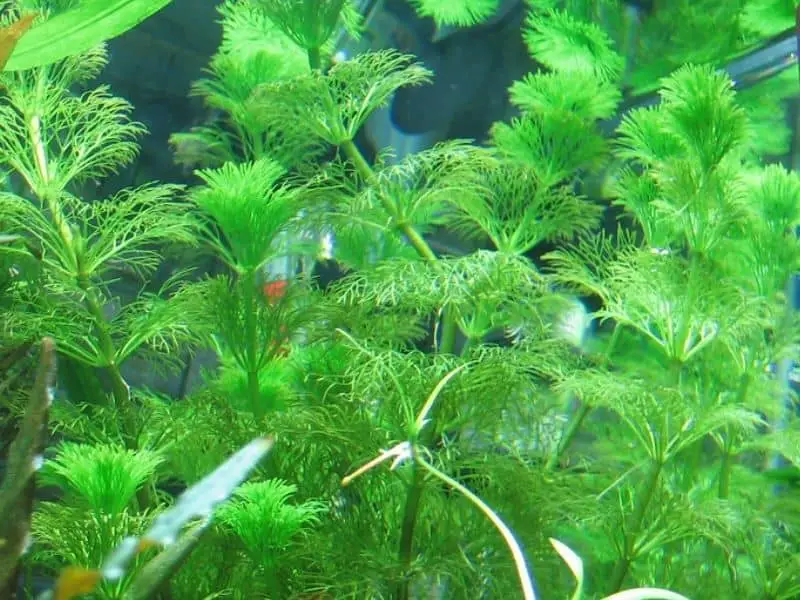
Lace Plant
| Parameters | Values |
| Scientific Name | Aponogeton madagscariensis |
| Family | Aponogetonaceae |
| Care Level | Moderate |
| Color | Light green |
| Maximum Size | 20+ Inches |
| Temperature | 72-820 F |
| pH | 6-7 pH |
| General Hardness | KH 3-6 |
| Light level | Moderate to high |
| Cost | $4.99-9.29 |
Lace Plant growing rate is low- moderate. The beautiful thing is, if you have this kind of aquarium plant in your tank, sometimes you have the ability to see flowers in your tank.
Lace Plants are expensive tall aquarium plants , as well as its leaves’ net-like structure, add extra value to this aquatic plant. This plant’s minimum lighting requirement level is 3-5W per gallon light. The suitable substrate is Sand and fine gravel substrate.
You should provide fertilizers that rich in iron and CO2 to reach the high growth level.
propagation of Lace plant
Flowers of lace plant die off, then seeds drop onto fine. Then new lace plants start to grow around the mother plant.
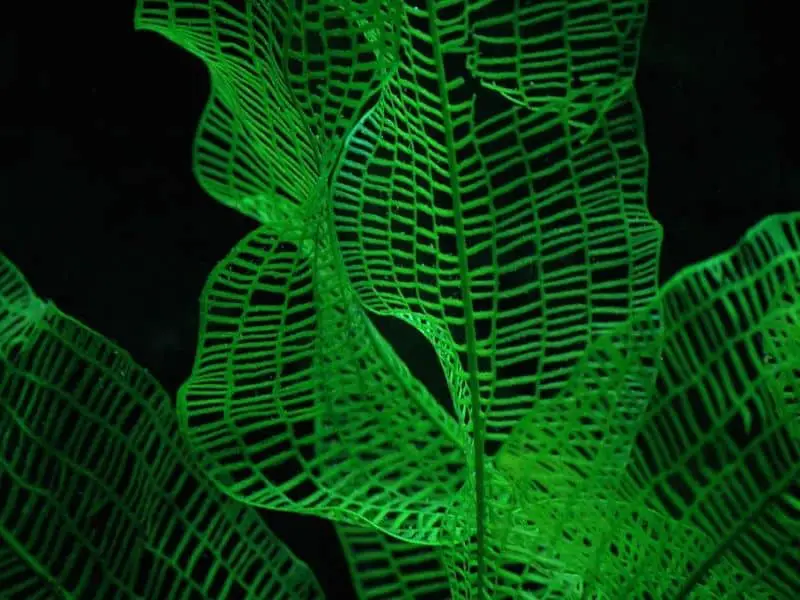
Water Wisteria
| Parameters | Values |
| Scientific Name | Hygrophila difformis |
| Family | Acanthaceae |
| Care Level | Easy |
| Color | Light green |
| Maximum Size | 20 Inches |
| Temperature | 70-820 F |
| pH | 6.5-7.5 pH |
| General Hardness | 2-8 KH |
| Light level | Moderate to high |
| Cost | $5 |
This is fast growing extra tall aquarium plant. This aquarium plant can be performed well in moderate lighting conditions and it should need at least 2-3W per gallon light. Generally, this plant is very hardy and no need to fertilize regularly.
Generally, the ideal substrate is sand, but you can plant this plant in fine gravel substrate.
Propagation of Water Wisteria
This plant propagates very fast. The best propagation method is plant cutting.
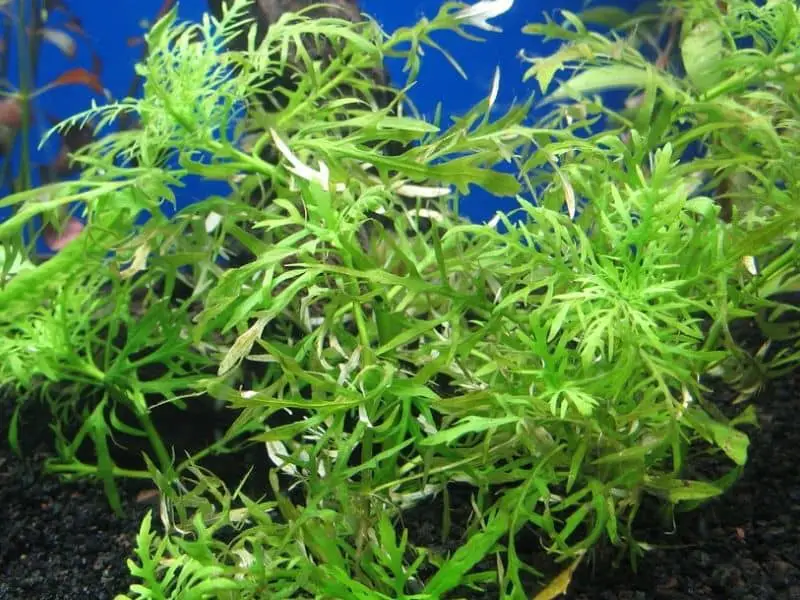
Rotala Indica
| Parameters | Values |
| Scientific Name | Rotala indica |
| Family | Lythraceae |
| Care Level | Moderate |
| Color | green |
| Maximum Size | 31 Inches |
| Temperature | 72-820 F |
| pH | 6.5-7.5pH |
| General Hardness | KH 3-8 |
| Light level | Moderate to high |
| Cost | $5 |
Rotala indica is known as Rotala Rotundifolia. This aquarium plant is fragile and it is not the best choice for beginners. Further, aggressive fish can damage this plant. Therefore, if you have aggressive fish, this plant is not suited to your tank.
It needs at least 3-5W per gallon. This extra tall aquarium plant requires supplements for their better growth. You should feed them on fertilizers with trace elements, iron, and potassium. Supplement with extra CO2 improves the red coloration of the plant.
Propagation of Rotala indica
You can generate a new plant by cutting the top half of a strong stem. Then you can replant it to generate a new plant.
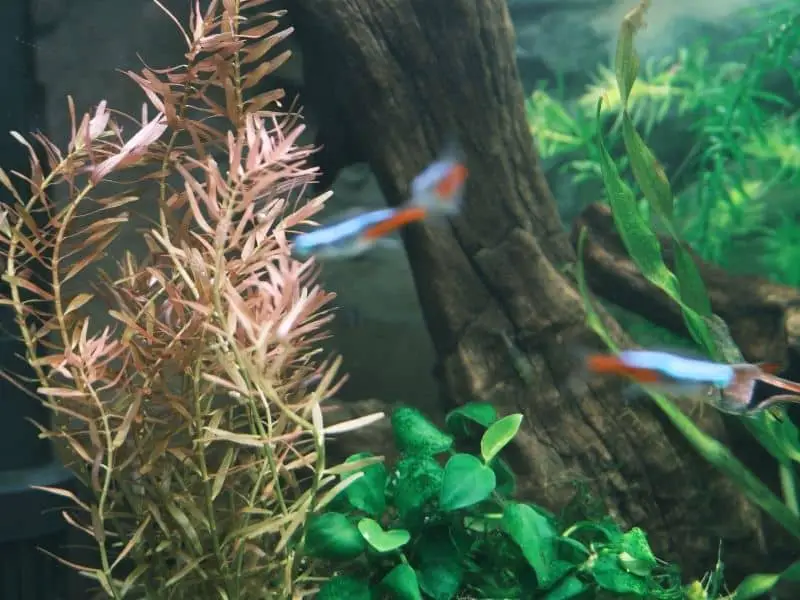
Green Cabomba
| Parameters | Values |
| Scientific Name | Cabomba caroliniana |
| Family | Cabombaceae |
| Care Level | Moderate |
| Color | Green |
| Maximum Size | 11 Inches |
| Temperature | 72-820 F |
| pH | 6.8-7.5 pH |
| General Hardness | kH 3-8 |
| Light level | Moderate to high |
| Cost | $6 |
Green Cabomba is called Carolina fanwort or Brazilian fanwort. This stem plant is delicate and you should pay more attention to protect this plant. This plant is not suited for the aquarium that has plant-eaters like goldfish.
Do not forget to provide a 3W per gallon light to this plant. The special thing is Green Cabomba has the ability to grow without any substrate. Applying liquid fertilizers helps to their growth.
Propagation of Green Cabomba
Cut young branches from the matured plants and replant them.
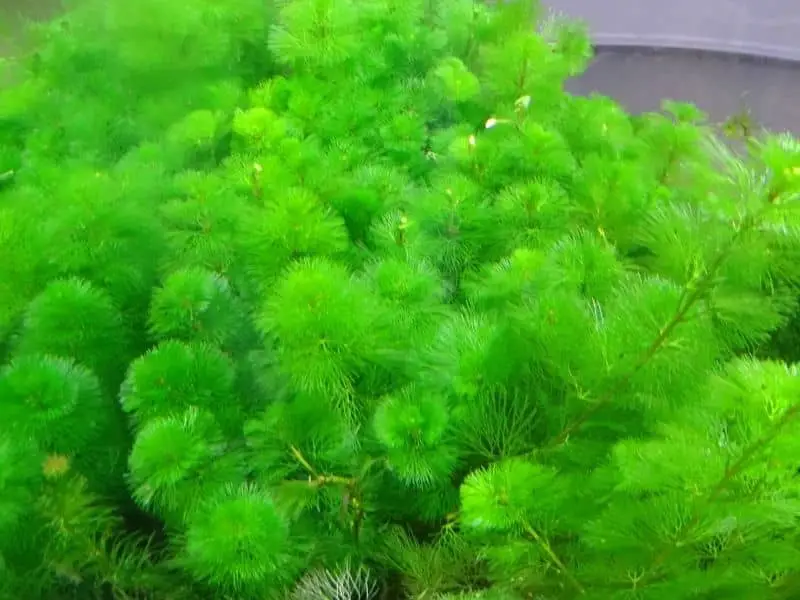
Java Fern
| Parameters | Values |
| Scientific Name | Microsorum pteropus |
| Family | Polypodiaceae |
| Care Level | Easy |
| Color | Dark green |
| Maximum Size | 13.5 Inches |
| Temperature | 68-820 F |
| pH | 6-7.5 pH |
| General Hardness | 60-160 ppm |
| Light level | Low to Moderate |
| Cost | $5-6 |
Java Fern is ideal for beginners due to its low care level. Further, it is hardy. Because of that, it can survive without fertilizers. Java Fern does not have the ability to survive in high lighting conditions.
If your plant is in a high lighting condition, its leaves become brown and transparent gradually. The ideal lighting level is 1.5-2W per gallon light. These tall aquarium plants do not have true roots but they have rhizomes that help to attach to the objects like rocks and driftwoods.
Propagation of Java Fern
There are two propagation methods. The first one is you can cut the rhizome in half. And then replant. Another one is tiny Java ferns that develop on the leaves.
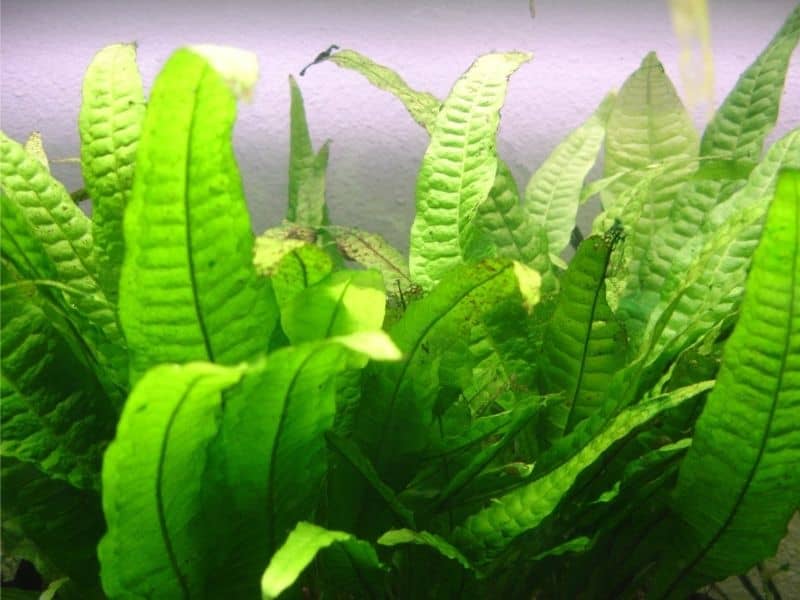
Anacharis
| Parameters | Values |
| Scientific Name | Elodea sp. |
| Family | Hydrocharitaceae |
| Care Level | Easy |
| Color | green |
| Maximum Size | 6 to 8 Inches |
| Temperature | 60-820 F |
| pH | 6.5-7.5 pH |
| General Hardness | kH 3-8 |
| Light level | Moderate |
| Cost | $3-6 |
Anacharis is a popular and fast-growing extra tall aquarium plants especially the Tetra aquarium. Anacharis can get nutrients from its environment through allelopathic abilities. The minimum lighting condition is 2W light per gallon. High lighting conditions cause to grow algae on its leaves.
Propagation of Anacharis
Propagation can be occurred by cutting the healthy stem off the mother plant.
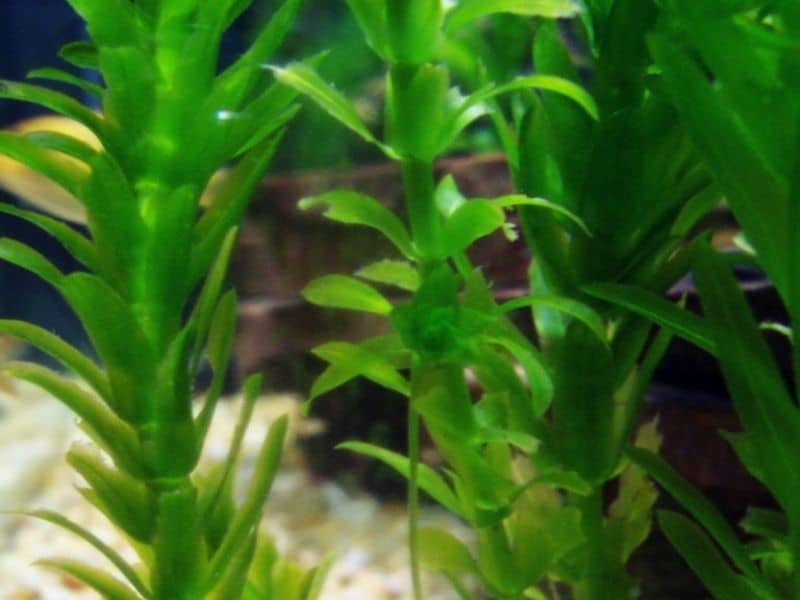
Water Sprite
| Parameters | Values |
| Scientific Name | Ceratopteris sp |
| Family | Petridaceae |
| Care Level | Easy |
| Color | green |
| Maximum Size | 13.5 Inches |
| Temperature | 68-820 F |
| pH | 6-7.5 pH |
| General Hardness | kH 3-8 |
| Light level | Medium to high |
| Cost | $ 7-8 |
Water sprite can plant on any substrate. The minimum lighting condition is 2-3W per gallon light.
Propagation of Water sprite
Cut the stems and allow to float them on the surface of the water.
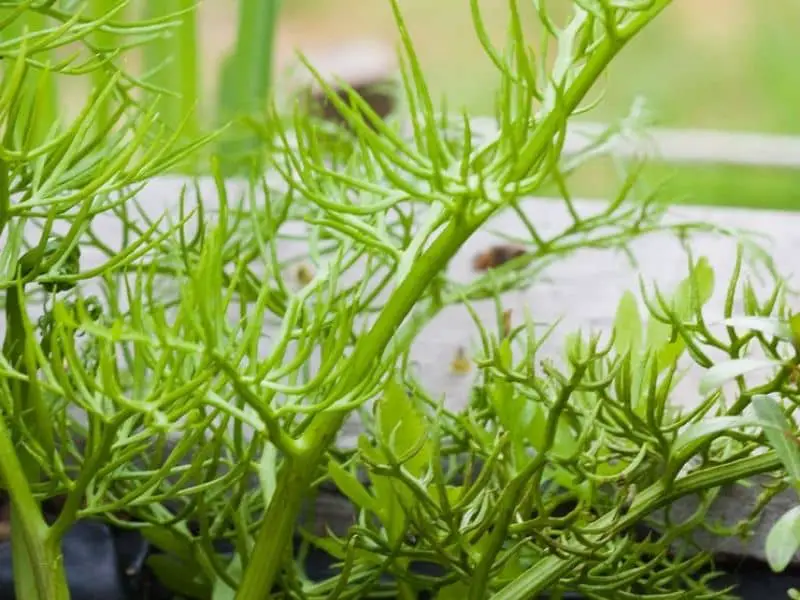
Brazillian Pennywort
| Parameters | Values |
| Scientific Name | Hydrocotyle leucocephala |
| Care Level | Easy |
| Color | Green leaves with white-ish roots |
| Maximum Size | 8 Inches |
| Temperature | 68-820 F |
| pH | 6-7.8 pH |
| General Hardness | kH 3-8 |
| Light level | Moderate |
| Cost | $7- 8 |
Brazillian pennywort is the best floating aquarium plant and it’s best for your Tetra aquarium, because this plant makes more hiding places for your Tetra. You must provide 2-3W per gallon to maintain their better performance.
Any substrate suite for your Brazillian pennywort plant and if your substrate rich in nutrients, it will help to plant’s growth. This plant needs nitrogen and iron. Because you should feed on supplements that include iron and nitrogen.
Propagation of Brazillian Pennywort
Cut the stems and allow to float them on the surface of the water.
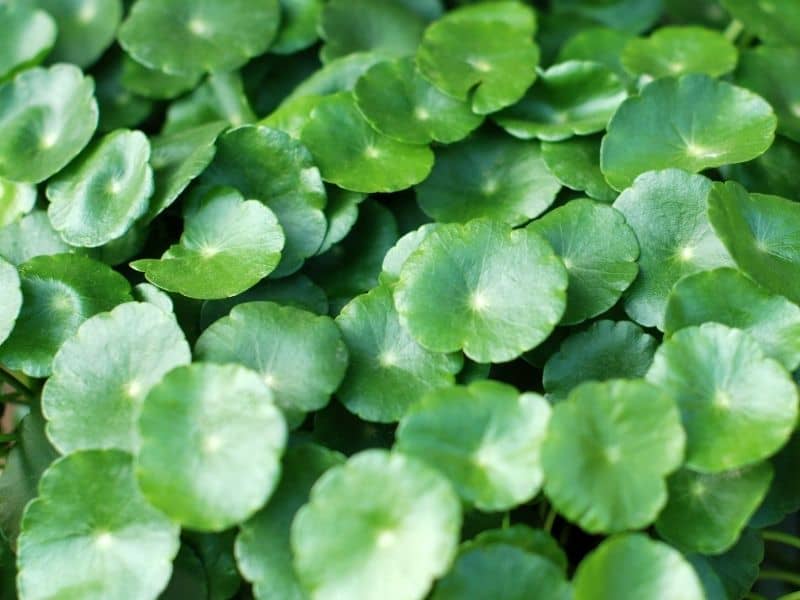
Green Foxtail
| Parameters | Values |
| Scientific Name | Myriophyllum Pinnatum |
| Family | Halorhagaceae |
| Care Level | Easy |
| Color | Green |
| Maximum Size | 24 Inches |
| Temperature | 72-820 F |
| pH | 6.5-7.5 pH |
| General Hardness | kH 3-8 |
| Light level | Moderate |
| Cost | $4 |
This aquarium plant does not need high lighting conditions. The minimum survival lighting condition is 2 to 3 W per gallon. Any light suits for Green foxtail. But the better lights are full-spectrum aquarium lights.
You can use soil and gravel substrate to plant this aquarium plant. Fertilizers are not compulsory but supplements will help to speed up the growth of the plant.
Propagation of Green Foxtail
You can generate new plants by cutting.
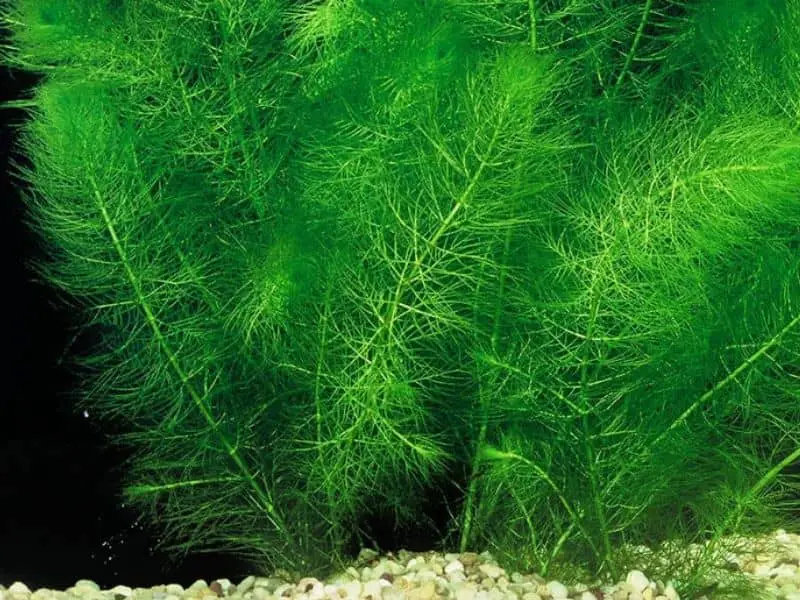
Giant Hygro
| Parameters | Values |
| Scientific Name | Hygrophila corymbosa |
| Family | Acanthaceae |
| Care Level | Easy |
| Color | Dark green to pink |
| Maximum Size | 24 Inches |
| Temperature | 72-840 F |
| pH | 6-7.5 pH |
| General Hardness | 71.43-321.43 ppm |
| Light level | Medium |
| Cost | $4-5 |
Giant Hygro or Temple plants are fast-growing tall aquarium plants. it performs well in moderate lighting level and the ideal level is 2-3 W per gallon from a full spectrum bulb of 5000-7000K. Any substrate is a match for this plant. This aquarium plant needs fertilizers include iron and trace elements regularly.
Propagation of Giant Hygro
Simply cut off the segment and replant in the substrate of the tank.

Aponogeton Crispus
| Parameters | Values |
| Scientific Name | Aponogeton Crispus |
| Family | Aponogetonaceae |
| Care Level | Easy |
| Color | Light green and red color leaves |
| Maximum Size | 9-10 Inches |
| Temperature | 64-860 F |
| pH | Below 7.5 pH |
| General Hardness | dH |
| Light level | Moderate |
| Cost | $8-9 |
Aponogeton Crispus can maintain easily, but this plant needs more nutrients to grow. Because of that, you should choose a nutrient-rich substrate for your plant. However, this plant can grow in the sand substrate.
But if you choose sand substrate, you should fertile the plant regularly with root tabs. Anyhow, you must apply liquid fertilizers, generally after the weekly water change.
Propagation of Aponogeton Crispus
Propagation is normally occurred by seeds. But you can generate new plants by splitting the rhizome.
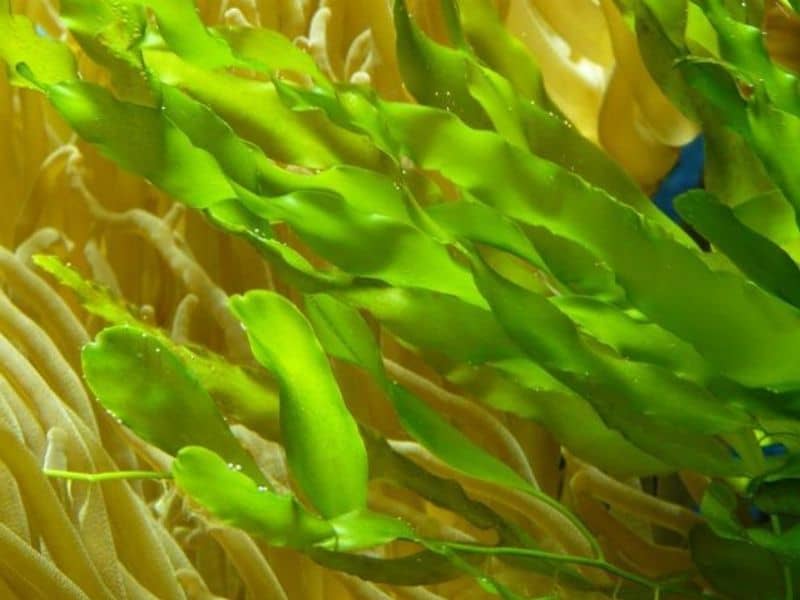
Cryptocoryne Wendtii
| Parameters | Values |
| Scientific Name | Cryptocoryne wendtii |
| Family | Araceae |
| Care Level | Easy |
| Color | Red, Brown and Green |
| Maximum Size | 6 Inches |
| Temperature | 72-820 F |
| pH | 6-8 pH |
| General Hardness | KH 3-8 |
| Light level | Low |
Cryptocoryne wendtii is one of the famous freshwater aquarium plants. you can plant this in any substrate. You should fertilize this plant with root tabs that rich in iron.
Propagation of Cryptocoryne wendtii
To generate new plants, it is only needed portion of roots with living nodes.
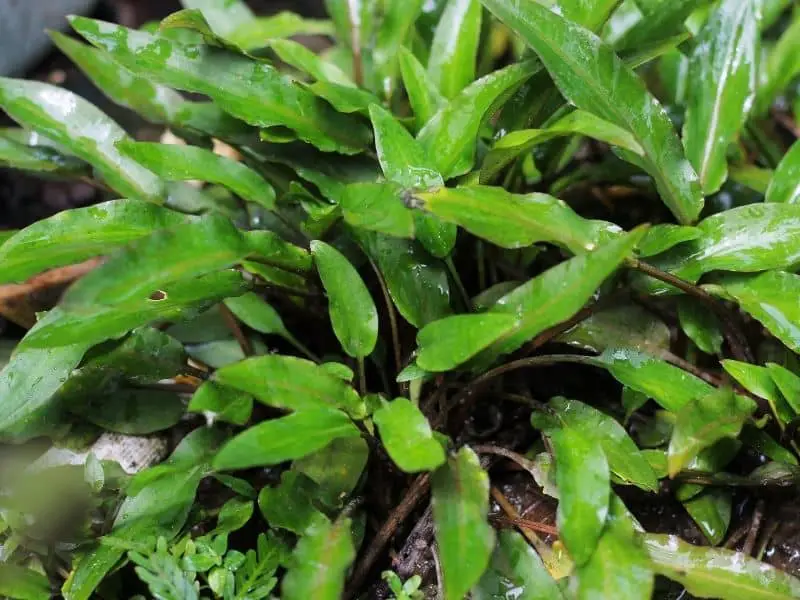
Hornwort
| Parameters | Values |
| Scientific Name | Anthocerotophyta sp |
| Family | Ceratophyllaceae |
| Care Level | Easy |
| Color | Dark green |
| Maximum Size | 10 foot |
| Temperature | 59-860 F |
| pH | 6-7.5 pH |
| General Hardness | 5-15dGH |
| Light level | Medium |
| Cost | $4-5 |
Hornwort is a fast-growing plant and easy to grow. This plant is the best oxygenating plant. The growth of Hornwort depends on the lighting condition. If you provide high lighting conditions, your plant grows fast.
But high lighting conditions cause to grow algae. Therefore, you should maintain moderate lighting conditions to reach proper growth. Further, this plant does not have true roots.
Propagation of Hornwort
Hornwort can be propagated through vegetative fragmentation. You can separate a part of the plant from the parent plant. Then it can grow as a new plant.
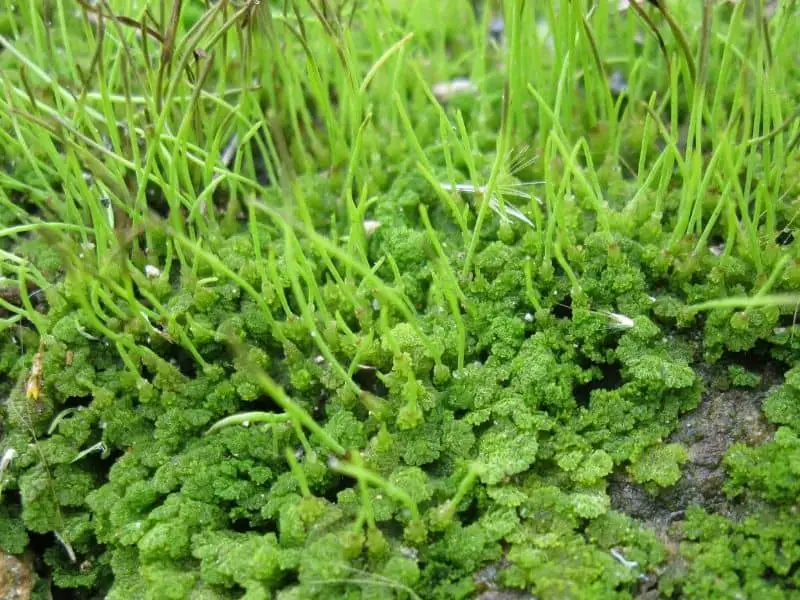
Italian Vallisneria
| Parameters | Values |
| Scientific Name | Vallisneria spiralis |
| Family | Hydrocharitaceae |
| Care Level | Easy |
| Color | green |
| Maximum Size | 11.81-21.65 Inches |
| Temperature | 72-800 F |
| pH | 6-7.5 pH |
| General Hardness | 4-180 N |
| Light level | Moderate |
| Cost | $2-3 |
Italian Vallisneria is very cheap. The minimum light condition that the plant need is 2W per gallon. If you provide more than this, it causes to increase in the growth rate of the plant. you have the ability to use any substrate to plant Italian Vallisneria.
This plant is hardy and does not need fertilizers. But if you apply supplements, it causes to increase the growth.
Propagation of Italian Vallisneria
Italian Vallisneria propagates through runners. Matured plants release runners and then these spread all over the tank.
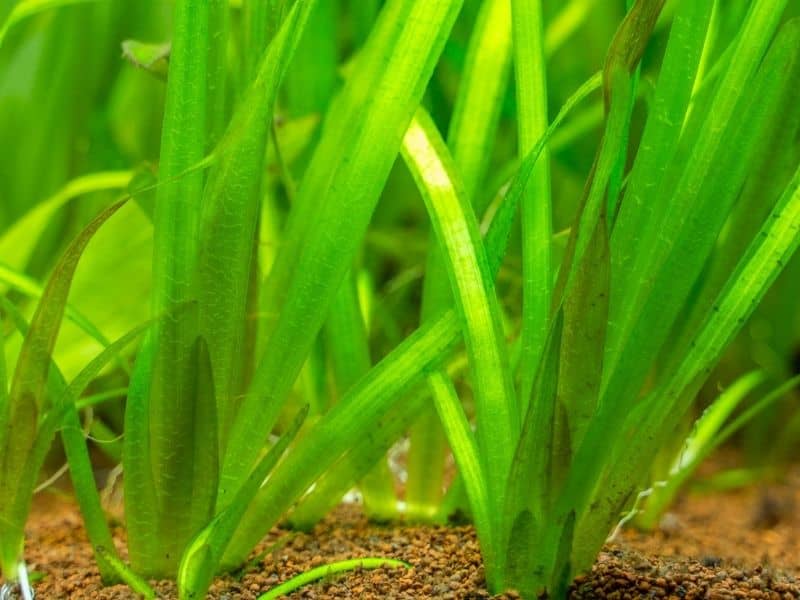
Moneywort
| Parameters | Values |
| Scientific Name | Bacopa monnieri |
| Family | Scropulariacase |
| Care Level | Moderate |
| Color | Bright green |
| Maximum Size | 12+ Inches |
| Temperature | 72-820 F |
| pH | 6.5-7.5 pH |
| General Hardness | KH 3-8 |
| Light level | Moderate to high |
| Cost | $3-4 |
Moneywort is a stem, moderately hardy plant. you should provide at least 2W per gallon full-spectrum light. Any substrate suite for this plant.
Propagation of Moneywort
Moneywort can propagate through cutting. Generally, white roots generate all leaf nodes. When roots grow about 1 inch, you can cut the stem and replant it in the substrate of your tank.

How to maintain tall aquarium plants
The important thing is you should select a better suitable extra tall aquarium plant by considering the environment of your tank. Then to keep your extra tall aquarium plant healthily, you have to follow several things.
- You should provide the required lighting condition for the plant
- Maintain the appropriate temperature
- Maintaining pH level and hardness of the water is important.
- Choose a better substrate for your aquarium plant
- Provide the right lighting condition
- Make sure your plants are getting enough nutrients and fertilize them properly
- Change the water of your tank properly.
How to anchor tall aquarium plants in the tank
Anchors help aquarium plants to prevent them from floating on the surface of the water.
- Tie your tall plant roots to rock
- Wrap the tall plant’s roots around the driftwood
- Keep the plants in the suitable pots
- Use the tall plant appropriate anchors
- Use the thick base of sand as a substrate
- Plant your tall plants in the crevices
Read More : How to get lush green aquarium plants | 5 points to check
